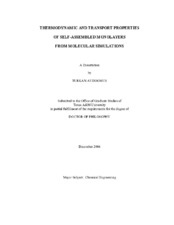| dc.description.abstract | The purpose of the work is to employ molecular simulation to further extend the understanding of Self-Assembled Monolayers (SAMs), especially as it relates to three particular applications: organic-inorganic composite membranes, surface treatments in Micro-Electro-Mechanical Systems (MEMS) and organic-surface-modified Ordered Mesoporous Materials (OMMs).
The first focus area for the work is the use of SAMS in organic-inorganic composite membranes for gas separations. These composite membranes, recently proposed in the literature, are based on the chemical derivatization of porous inorganic surfaces with organic oligomers. Our simulations achieve good qualitative agreement with experiment in several respects, including the improvement in the overall selectivity of the membrane and decrease in the permeance when increasing the chain length. The best improvement in the overall solubility selectivity is reached when the chains span throughout the pore.
The second application focus is on the use of SAMs as coatings in MEMS devices. The work focuses on the modeling of adhesion issues for SAM coatings at the
molecular level. It is shown that as the chain length is increased from 4 to 18 carbon atoms, the adhesion forces between two monolayers at the same separations decreases.
The third application focus is on the use of SAMs for tailoring surface and structural properties of OMMs, in particular, porous silicas. A molecular study of structural and surface properties of a silica material with a 5 nm pore size, modified via chemical bonding of organosilanes with a range of sizes (C4, C8 and C18) is presented. Grand canonical MC simulations are employed to obtain nitrogen adsorption isotherms for unmodified and modified MCM-41 material models. Furthermore, the density profiles of alkyl chains and nitrogen molecules are analyzed to clarify the differences in the adsorption mechanisms in unmodified and modified materials. The position of the capillary condensation steps gradually shifted to lower pressure values with the increase in size of the bonded ligands, and this shift was accompanied by a gradual disappearance of the hysteresis loop. As the length of the bonded ligands is increased, a systematic decrease in the pore diameter is observed and the multi-layer adsorption mechanism in modified model materials diminishes. | en |


